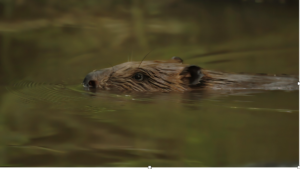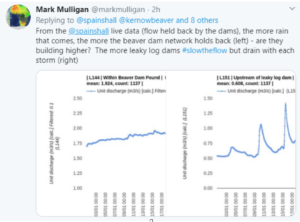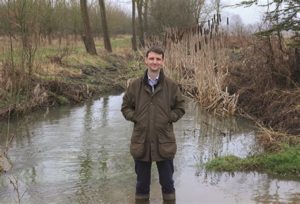Dam Good Job – Beavers back in Essex after 400 years.
Dramatic stories and pictures of flooded towns and villages all over England dominated the news in the early part of this year, pre-Covid, whilst in the Summer months our rivers and streams ran dry for lack of rain or excess water abstraction. And while arguments rage over housebuilding on flood plains, straightening of river courses, and destruction of woodland, our rivers are clearly in trouble with fish stocks dangerously low and threats to insect-life, reptiles and birdlife associated with a healthy river ecosystem.
This is where Beavers may be able to help. Once widespread throughout Britain, they were hunted to extinction by the end of the 16th century. Now they are being re-introduced in small numbers in controlled projects in several counties.
“They are nature’s water manager”
says Derek Gow, a farmer and ecologist in Devon who has created his own wetland enclosure with about twenty-five beavers. They slow, clean and store water, creating a more natural flow pattern with their intricate network of dams and ponds. Studies suggest that a wetland area can hold up to forty times as much water when beavers are present. According to Gow, they reinstall “sponges” to the landscape, trapping water and releasing gradually rather than letting it cascade down to river valleys.
In 2019 a pair of beavers were introduced into an enclosure in North Essex as part of a ten year project designed to reduce the severity of flooding in the picturesque village of Finchingfield. Led by landowner Archie Ruggles-Brise of Spains Hall Estate, and partners from the Essex and Suffolk Rivers Trust, Essex Wildlife Trust and Environment Agency, the scheme involves a series of man-made timber leaky dams constructed alongside beaver dams, with the changes and impacts being closely monitored.
After work in Devon highlighted beavers’ ability to re-establish wetlands for water storage, Archie was keen to pilot the approach in drought-prone East Anglia and within an intensively farmed landscape to extend understanding beyond upland, grazed and moorland regions.

One of the Essex Beavers (photo credit Russell Savory)
“It became clear to me that whilst we can construct dams to hold back water, and wetlands to store water, it’s rare for all these things to happen together, and once they are constructed they require active maintenance. Our traditionally limited project focus means we miss out of potential benefits by being too prescriptive. Beavers on the other hand carry on building their dams, digging canals, opening up woodland and getting on with their work for as long as they are present. This leads to a cumulative impact rather than declining one as time goes on.”
Furthermore they create thriving wetland environments that benefit many other species including water voles, wild fowl, water beetles and dragonflies which in turn support breeding fish and insect-eating birds.

Floods in Finchingfield Village.
Finchingfield suffers from periodic flooding which affects eighteen properties in the village. The Spains Hall Estate covers nearly half of the river catchment upstream of the village and, whilst none of the flooded properties are owned by the estate, the landowners had always wanted to do something to help.
The two beavers, living within a fenced in 4-hectare woodland enclosure have already built twenty dams in year one.

A dam made of sticks and mud built by the Eurasian Beavers (c) Archie Ruggles-Brise
Together with eight man-made leaky dams they make up a wetland area that holds as much water as an Olympic-sized swimming pool, slowing flow during floods, and releasing it slowly once the rain subsides.

A man-made ‘leaky dam’ made of timber from the Estate (c) Archie Ruggles-Brise
Until recently the cost-benefit criteria for government funded flood defences meant that small rural settlements like Finchingfield were unable to get government support, leaving them vulnerable to ongoing flooding. However, in 2015 Defra announced a policy shift which opened the door to the concept of ‘Natural Flood Management’ (NFM). NFM is the deployment of small-scale (often timber) structures, set in the landscape and working with natural processes, rather than large engineering projects. It is most successful in smaller upstream areas of river catchments where water volumes are lower and the capacity to use surrounding land to temporarily store water is high.
Defra’s announcement enables environmental NGOs like the Rivers Trusts to be able to access funds to work with landowners to deliver flood risk projects to benefit farmland and smaller settlements. In the case of the Finchingfield project funding was advanced by the Regional Flood and Coastal Committee, a first for the region.
The Essex and Suffolk Rivers Trust, who secured the RFCC funding said, “We have welcomed the opportunity to work with Spains Hall Estate on this project as it demonstrates the role that landowners can play to benefit the wider community in helping to reduce flood risk and the vital role they can play in this. We were also interested in seeing how man-made interventions, such as leaky dams, fare against natural interventions, in this case the introduction of beavers. The way the beavers are shaping their environment and the effects this has on holding water upstream and reducing flooding downstream, may help to improve natural flood management projects going forward.”
The Essex Wildlife Trust, who are monitoring the ecological impacts of the project, have already started to see benefits for other wildlife. A rarely observed Water Shrew has already been seen in the beaver ponds. Darren Tansley, Essex Wildlife Trust River Catchment Coordinator and project Ecologist said, “The project is giving us fabulous insights into the speed with which wildlife can respond to the beaver’s engineering and wetland creation. The appearance of kingfisher and water shrew indicates that fish and aquatic insects are thriving, and it is precisely these groups that are the foundation of a healthy, functioning ecosystem.”

A tweet from Mark Mulligan (Kings College London Geography Department, and lead investigator on the #Freestations project highlighting data on how beaver dams and man-made leaky dams respond in real time to rainfall events (17th February 2020)
The Environment Agency are monitoring the water quality and levels and, despite the prolonged dry spells since the project started in March 2018, are also seeing some impacts. Matt Butcher, Catchment Co-ordinator for the EA said, “We have already measured the water level increase upstream of the beaver dams following rainfall, and this water is slowly released over several weeks. In prolonged dry periods, not only do the dams provide valuable wet woodland habitat and reduce the risk of flooding. They also help sustain life downstream with the gently trickle of water they release.”
Further expert partnerships have also been forged on the back of the project with Kings College London supplying water level, soil moisture and weather recording equipment as part of a wider insurance industry project to quantify the downstream flood damage costs reduction arising from upstream flood storage works.
Meanwhile the beavers, named Woody and Willow have settled in really well and this Summer became proud parents of two kits – the first beavers to be born in Essex for 400 years.

Beaver kit born at Spains Hall
“Before lockdown we were able to offer tours and photographic opportunities so that people could get up close to these magical animals,” says Archie, who gets a great write-up in TripAdvisor for his presentations and walking tours.

Archie Ruggles-Brise
Archie is adamant that the beaver project is not only a practical solution to a real-world flooding issue, but also shows that on a working estate, with farmland and a number of other diversification activities, environmental work can be revenue generator, contributing positively to a sustainable bottom line.
“We hope the project will also focus a spotlight on our little corner of rural North West Essex, a hidden gem normally only enjoyed by those in the know. We are keen to welcome more people to the area so they can see for themselves what they might be able to do back home.”


Wildlife filmmaker Russell Savory
A wonderful documentary film showing the beavers’ first year at Spains Hall has been made by the celebrated wildlife filmmaker Russell Savory and will be shown next year.For more information go to: www.spainshallestate.co.uk/nfm_beavers
Article by Archie Ruggles Brise and Emma Stewart-Smith.
